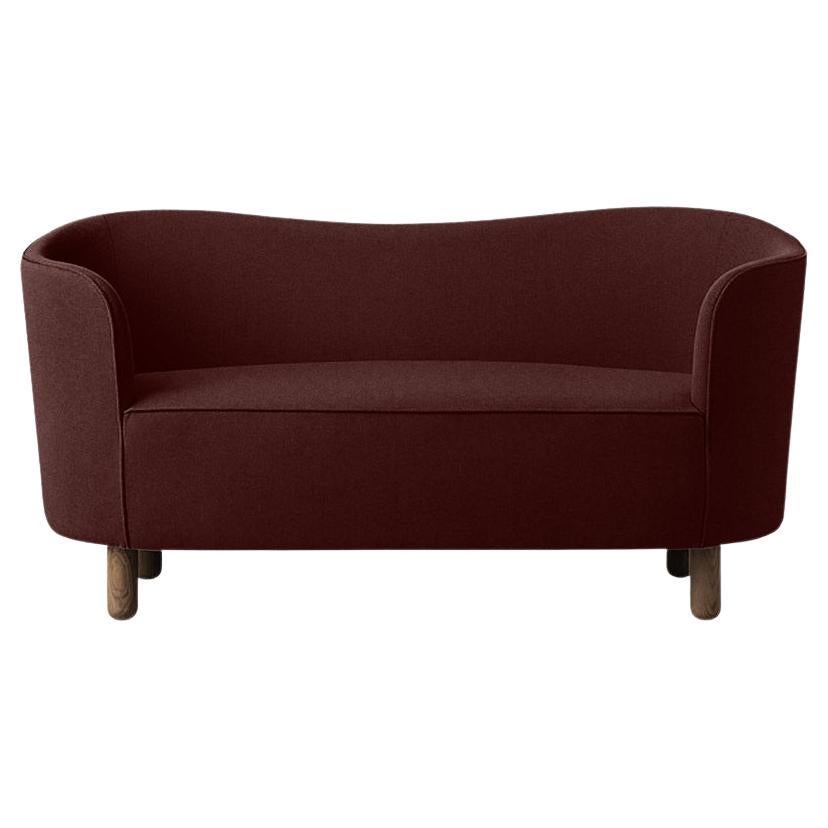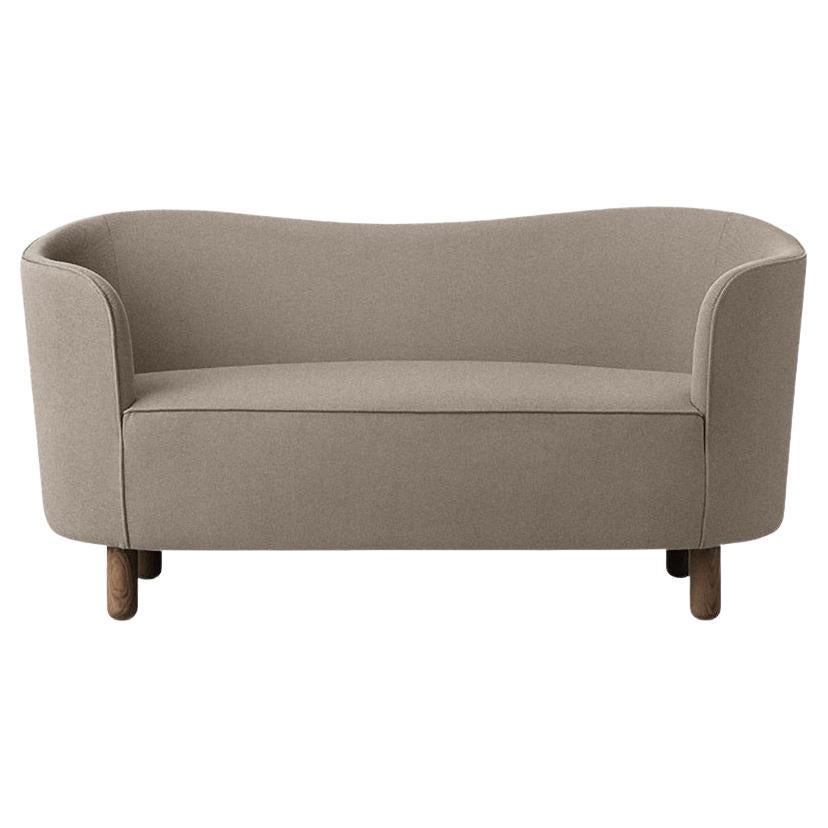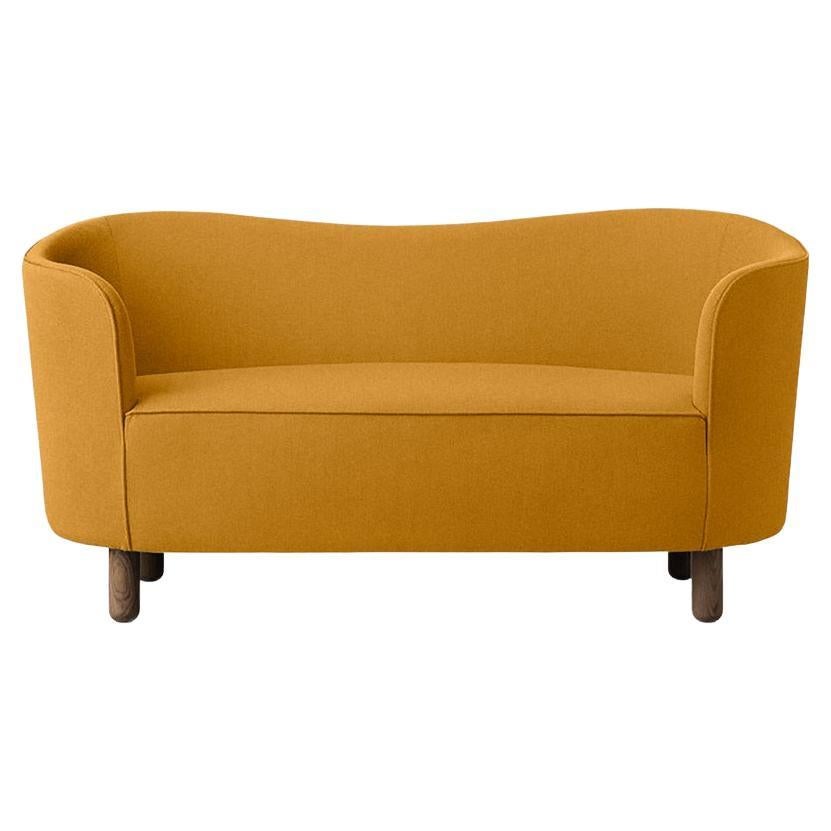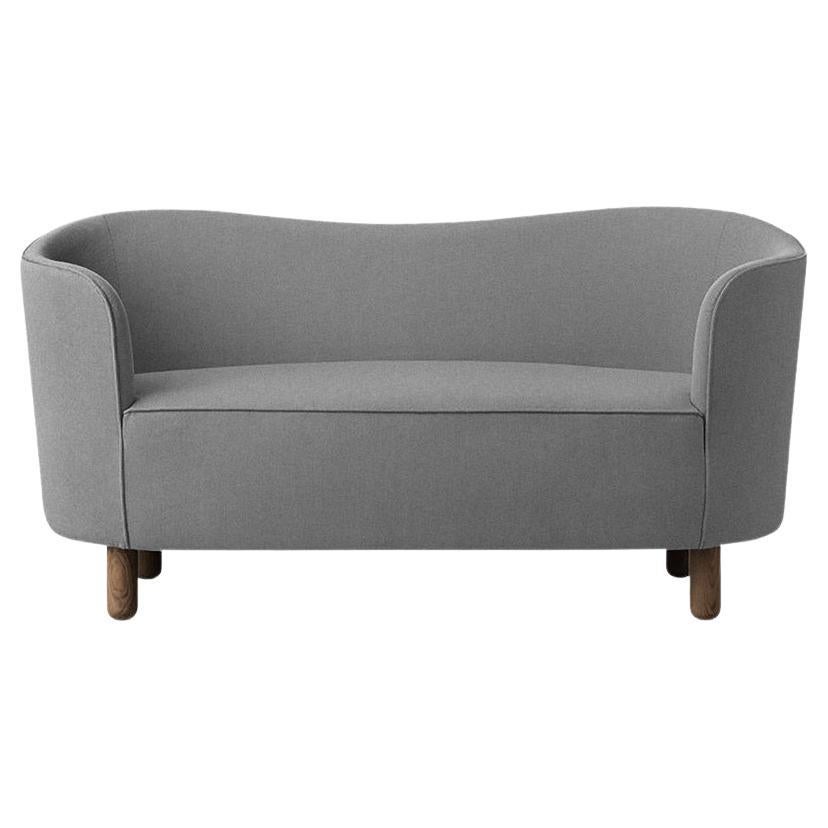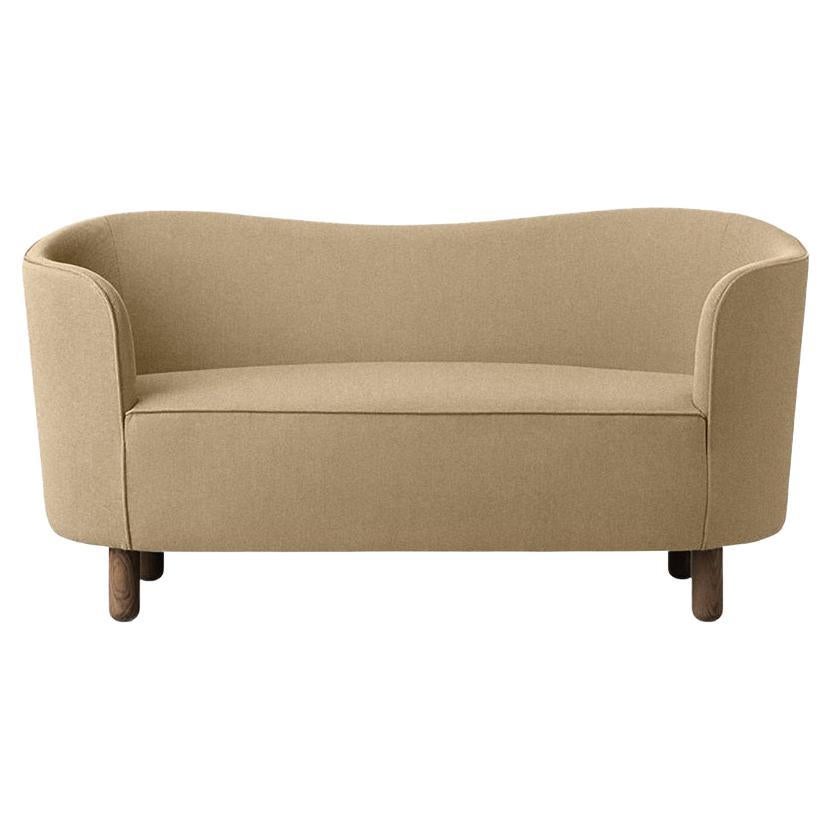Items Similar to Blue and Smoked Oak Raf Simons Vidar 3 Mingle Sofa by Lassen
Want more images or videos?
Request additional images or videos from the seller
1 of 7
Blue and Smoked Oak Raf Simons Vidar 3 Mingle Sofa by Lassen
About the Item
Blue and smoked oak raf simons vidar 3 mingle sofa by Lassen.
Dimensions: W 154 x D 68 x H 74 cm.
Materials: textile, oak.
The Mingle sofa was designed in 1935 by architect Flemming Lassen (1902-1984) and was presented at The Copenhagen Cabinetmakers’ Guild Competition in the same year. It was subsequently praised for its qualities as a small but elegant sofa in the professional journal “The Architect”. Flemming Lassen loved to travel, and he was often inspired by his journeys throughout Europe. He was very taken with both Italy and France, and had a burning desire to tour those countries on his motorcycle. Flemming Lassen wanted to create a sofa made for conversation with a comfort that invited people to stay seated and talk together for long periods of time. The armrests were designed to encircle the sitters, generating intimacy and transforming the sofa into a cosy place to relax. Flemming Lassen took inspiration from both French elegance and modern Italian style, and transferred the trends and his own ideas to a small, upholstered sofa called Mingle.
By Lassen is a Danish design brand focused on iconic designs created by Mogens and Flemming Lassen, founded by Lassens’ relatives in 2008. Brothers Mogens (1901-1987) and Flemming (1902-1984) Lassen are known as two of Denmark’s greatest architects and designers. Both were renowned pioneers of Danish functionalism and modernist architecture, honoured with numerous prestigious medals and awards. Headed by Mogens Lassen’s grandson Søren Lassen, By Lassen carries on the brothers’ design philosophy by manufacturing their iconic designs as well as products by other designers that complement the Lassen’s functionalist style. The company’s mission is to continue the tradition of timelessness, functionality and quality, and to introduce the Lassen’s design heritage to new generations.
- Dimensions:Height: 29.14 in (74 cm)Width: 60.63 in (154 cm)Depth: 26.78 in (68 cm)
- Style:Modern (Of the Period)
- Materials and Techniques:
- Place of Origin:
- Period:
- Date of Manufacture:2022
- Production Type:New & Custom(Current Production)
- Estimated Production Time:9-10 weeks
- Condition:
- Seller Location:Geneve, CH
- Reference Number:1stDibs: LU1219232917172
Galerie Philia
Galerie Philia is an international contemporary sculptural design and art gallery representing emerging and established designers and artists. The gallery is the brainchild of two brothers who share a lifetime passion for art, literature and philosophy. Their distinct academic background sets them apart from their peers, as it sees them following a rhizomatic and transcultural approach in the way they select works. This involves combining elements from multiple cultures in what becomes a network of harmoniously interconnected roots, ultimately revealing the beauty of each unique creation. The gallery’s non-hierarchical curation sits apart from the ephemerality of trends and focuses instead on the true aesthetic quality of the piece – alluring and timeless. Unlike others, Galerie Philia does not focus on a single style – whether minimalist, organic or raw – but rather embraces heterogeneity. The Galerie Philia takes pride in discovering new talents, providing them with multiple international platforms to showcase their latest creations. As well as propelling the newest generation of 21st century collectible design, Galerie Philia also works with internationally known design artists. Galerie Philia has a strong international presence, with galleries in Geneva, New York and Singapore. In addition to their permanent spaces, the gallery organizes temporary group exhibitions and artists residencies in first-class locations around the world.
Made to order creations can be done: please contact us for any request.

About the Seller
5.0
Diamond Seller
These expertly vetted sellers are 1stDibs' most experienced sellers and are rated highest by our customers.
Established in 2015
1stDibs seller since 2015
4,132 sales on 1stDibs
Typical response time: <1 hour
- ShippingRetrieving quote...Ships From: Copenhagen, Denmark
- Return PolicyA return for this item may be initiated within 7 days of delivery.
More From This SellerView All
- Maroon and Smoked Oak Raf Simons Vidar 3 Mingle Sofa by LassenLocated in Geneve, CHMaroon and smoked oak raf simons Vidar 3 mingle sofa by Lassen. Dimensions: W 154 x D 68 x H 74 cm. Materials: Textile, Oak. The Mingle sofa was designed in 1935 by architect F...Category
2010s Danish Modern Living Room Sets
MaterialsTextile, Oak
- Beige and Smoked Oak Raf Simons Vidar 3 Mingle Sofa by LassenLocated in Geneve, CHBeige and smoked oak Raf Simons Vidar 3 Mingle sofa by Lassen Dimensions: W 154 x D 68 x H 74 cm Materials: Textile, Oak. The Mingle sofa was designed in 1935 by architect Flem...Category
2010s Danish Modern Living Room Sets
MaterialsTextile, Oak
- Orange and Smoked Oak Raf Simons Vidar 3 Mingle Sofa by LassenLocated in Geneve, CHOrange and smoked oak raf simons vidar 3 mingle sofa by Lassen Dimensions: W 154 x D 68 x H 74 cm Materials: textile, oak. The Mingle sofa was designed in 1935 by architect Fle...Category
2010s Danish Modern Living Room Sets
MaterialsTextile, Oak
- Grey and Smoked Oak Raf Simons Vidar 3 Mingle Sofa by LassenLocated in Geneve, CHGrey and smoked oak Raf Simons Vidar 3 mingle sofa by Lassen. Dimensions: W 154 x D 68 x H 74 cm. Materials: Textile, oak. The Mingle sofa was designed in 1935 by architect Fle...Category
2010s Danish Modern Living Room Sets
MaterialsTextile, Oak
- Red and Smoked Oak Raf Simons Vidar 3 Mingle Sofa by LassenLocated in Geneve, CHRed and smoked oak Raf Simons Vidar 3 mingle sofa by Lassen Dimensions: W 154 x D 68 x H 74 cm Materials: Textile, oak. The Mingle sofa was designed in 1935 by architect Flemming L...Category
2010s Danish Modern Living Room Sets
MaterialsTextile, Oak
- Sand and Smoked Oak Raf Simons Vidar 3 Mingle Sofa by LassenLocated in Geneve, CHSand and smoked oak Raf Simons vidar 3 mingle sofa by Lassen Dimensions: W 154 x D 68 x H 74 cm Materials: textile, oak. The Mingle sofa was designed in 1935 by architect Flemm...Category
2010s Danish Modern Living Room Sets
MaterialsTextile, Oak
You May Also Like
- Carlo Scarpa Iroko and Velvet Cornaro Sofa for Studio Simon, 1974, Set of 2By Carlo Scarpa, Studio SimonLocated in Vicenza, ITSet of 2 Cornaro two-seater sofas, designed by Carlo Scarpa and manufactured by Studio Simon in 1974. Made of Iroko wood, foam, and azure chenille velvet. Excellent vintage conditi...Category
Vintage 1970s Italian Mid-Century Modern Living Room Sets
MaterialsChenille, Velvet, Foam, Wood
- Studio Simon Black Wood and Azure Velvet Two-Seater “Simone” Sofa, Italy, 1975By Studio SimonLocated in Vicenza, ITTwo-seater “Simone” sofa, designed and manufactured by Studio Simon in 1975. The structure is made of black lacquered wood. An azure velvet big seat completes the sofa. The min...Category
Vintage 1970s Italian Mid-Century Modern Sofas
MaterialsCotton, Velvet, Foam
- Carlo Scarpa Iroko Wood and Green Velvet Cornaro Sofa for Studio Simon, 1974By Carlo Scarpa, Studio SimonLocated in Vicenza, ITCornaro two-seater sofa, designed by Carlo Scarpa and manufactured by Studio Simon in 1974. Made of Iroko wood, foam, and azure chenille velvet. Excellent vintage condition. Born in Venice on June 2nd, 1906, Carlo Scarpa began working very early. Only a year after he had first qualified as an architect in 1926, he began working for the Murano glassmakers Cappellin & Co. in a consultative capacity; from 1927, he began to experiment with the Murano glass, and this research not only gave him excellent results here but would also inform his progress for many years to come. Between 1935 and 1937, as he entered his thirties, Carlo Scarpa accepted his first important commission, the renovation of Venice’s Cà Foscari. He adapted the spaces of this stately University building which stands on the banks of the Grand Canal, creating rooms for the Dean’s offices and a new hall for academic ceremonies; Mario Sironi and Mario De Luigi were charged with doing the restoration work on the frescos. After 1945, Carlo Scarpa was constantly busy with new commissions, including various furnishings and designs for the renovation of Venice’s Hotel Bauer and designing a tall building in Padua and a residential area in Feltre, all worth mentioning. One of his key works, despite its relatively modest diminished proportions, was the first of many works which were to follow in the nineteen fifties: the [bookshop known as the] Padiglione del Libro, which stands in Venice’s Giardini di Castello and shows clearly Scarpa’s passion for the works of Frank Lloyd Wright. In the years which were to follow, after he had met the American architect, Scarpa repeated similar experiments on other occasions, as can be seen, in particular, in the sketches he drew up in 1953 for villa Zoppas in Conegliano, which show some of his most promising work. However, this work unfortunately never came to fruition. Carlo Scarpa later created three museum layouts to prove pivotal in how twentieth-century museums were set up from then on. Between 1955 and 1957, he completed extension work on Treviso’s Gipsoteca Canoviana [the museum that houses Canova’s sculptures] in Possagno, taking a similar experimental approach to the one he used for the Venezuelan Pavilion at [Venice’s] Giardini di Castello which he was building at the same time (1954-56). In Possagno Carlo Scarpa was to create one of his most incredible ever works, which inevitably bears comparison with two other museum layouts that he was working on over the same period, those of the Galleria Nazionale di Sicilia, housed in the Palazzo Abatellis in Palermo (1953-55) and at the Castelvecchio in Verona (1957- 1974), all of which were highly acclaimed, adding to his growing fame. Two other buildings, which are beautifully arranged in spatial terms, can be added to this long list of key works that were started and, in some cases, even completed during the nineteen fifties. After winning the Olivetti Award for architecture in 1956, Scarpa began work in Venice’s Piazza San Marco on an area destined to house products made by the Industrial manufacturers Ivrea. Over the same period (1959-1963), he also worked on renovating and restoring the gardens and ground floor of the Fondazione Querini Stampalia in Venice, which many consider one of his greatest works. While he worked on-site at the Fondazione Querini Stampalia, Carlo Scarpa also began building a villa in Udine for the Veritti family. To shed some light on how much his work evolved over the years, it may be useful to compare this work with that of his very last building, villa Ottolenghi Bardolino, which was near completion at the time of his sudden death in 1978. Upon completion of villa Veritti over the next ten years, without ever letting up on his work on renovation and layouts, Scarpa accepted some highly challenging commissions which were to make the most of his formal skills, working on the Carlo Felice Theatre in Genoa as well as another theatre in Vicenza. Towards the end of this decade, in 1969, Rina Brion commissioned Carlo Scarpa to build the Brion Mausoleum in San Vito d’Altivole (Treviso), a piece he continued to work on right up until the moment of his death. Nevertheless, even though he was totally absorbed by work on this mausoleum, plenty of other episodes can offer some insight into the final years of his career. As work on the San Vito d’Altivole Mausoleum began to lessen in 1973, Carlo Scarpa started building the new headquarters for the Banca Popolare di Verona. He drew up plans that were surprisingly different from the work he carried out simultaneously on the villa Ottolenghi. However, the plans Carlo Scarpa drew up, at different times, for a monument in Brescia’s Piazza della Loggia commemorating victims of the terrorist attack on May 28th, 1974, make a sharp contrast to the work he carried out in Verona, almost as if there is a certain hesitation after so many mannered excesses. The same Pietas that informs his designs for the Piazza Della Loggia can also be seen in the presence of the water that flows through the Brion Mausoleum, almost as if to give a concrete manifestation of pity in this twentieth-century work of art. Carlo Scarpa has put together a highly sophisticated collection of structures occupying the mausoleum’s L-shaped space stretching across both sides of the old San Vito d’Altivole cemetery. A myriad of different forms and an equally large number of different pieces, all of which are separate and yet inextricably linked to form a chain that seems to offer no promise of continuity, arising out of these are those whose only justification for being there is to bear the warning “si vis vitam, para mortem,” [if you wish to experience life prepare for death] as if to tell a tale that suggests the circle of time, joining together the commemoration of the dead with a celebration of life. At the entrance of the Brion Mausoleum stand the “propylaea,” followed by a cloister that ends by a small chapel, with an arcosolium bearing the family sarcophagi, the central pavilion, held in place on broken cast iron supports, stands over a mirror-shaped stretch of water and occupies one end of the family’s burial space. The musical sound of the walkways, teamed with the luminosity of these harmoniously blended spaces, shows how, in keeping with his strong sense of vision, Carlo Scarpa could make the most of all his many skills to come up with this truly magnificent space. As well as an outstanding commitment to architectural work, with the many projects we have already seen punctuating his career, Carlo Scarpa also made many equally important forays into the world of applied arts. Between 1926 and 1931, he worked for the Murano glassmakers Cappellin, later taking what he had learned with him when he went to work for the glassmakers Venini from 1933 until the 1950s. The story of how he came to work on furniture design is different, however, and began with the furniture he designed to replace lost furnishings during his renovation of Cà Foscari. The later mass-produced furniture started differently, given that many pieces were originally one-off designs “made to measure.” Industrial manufacturing using these designs as prototypes came into being thanks to the continuity afforded him by Dino Gavina, who, as well as this, also invited Carlo Scarpa to become president of the company Gavina SpA, later to become SIMON, a company Gavina founded eight years on, in partnership with Maria Simoncini (whose own name accounts for the choice of company name). Carlo Scarpa and Gavina forged a strong bond in 1968 as they began to put various models of his into production for Simon, such as the “Doge” table, which also formed the basis for the “Sarpi” and “Florian” tables. In the early seventies, other tables that followed included “Valmarana,” “Quatour,” and “Orseolo.” While in 1974, they added a couch and armchair, “Cornaro,” to the collection and the “Toledo” bed...Category
Vintage 1970s Italian Mid-Century Modern Living Room Sets
MaterialsVelvet, Foam, Chenille, Wood
- Studio Simon Minimalist Black Leather Three-Seater “Simone” Sofa, Italy, 1975By Studio SimonLocated in Vicenza, ITThree-seater “Simone” sofa, designed and manufactured by Studio Simon in 1975. The structure is made of black lacquered wood. A black leather big seat completes the sofa. The m...Category
Vintage 1970s Italian Mid-Century Modern Sofas
MaterialsLeather, Beech, Foam
- Brazilian Oak and Olive Green Leather 3-Seat Sofa, Jean GillonBy Jean GillonLocated in Voorburg, NLA wonderful original matching 1970s Brazilian sofa attributed to Jean Gillon. This amazing comfortable 3-seater has a unique washed dark-grey oak frame and soft Brazilian leather cus...Category
Mid-20th Century Brazilian Mid-Century Modern Sofas
MaterialsLeather, Oak
- Kazuhide Takahama White Velvet “Mantilla” Two-Seater Sofa for Studio Simon, 1973By Kazuhide Takahama, Studio SimonLocated in Vicenza, ITTwo-seater “Mantilla” sofa, designed by Kazuhide Takahama for Studio Simon in 1973. It is made of wood and polyurethane foam structure, with white velvet upholstery. Kazuhide T...Category
Vintage 1970s Italian Mid-Century Modern Sofas
MaterialsCotton, Velvet, Foam
Recently Viewed
View AllRead More
Galerie Philia Unveils Limited-Edition Designs at Giampiero Tagliaferri’s New L.A. Studio
For the exhibition “Materia Perpetua,” the gallery asked an international group of makers — including Tagliaferri — to explore the possibilities of a surprisingly versatile material: onyx.
Galerie Philia Doesn’t Just Discover Fresh Design Talent — It Grows It
With an impressive slate of international exhibitions, the Geneva-based gallery raises the profiles of emerging designers.
More Ways To Browse
French Country Living Room
Blue Oak
Love Seat Set
French Oak Living Room Sets
Blue French Sofa
French Blue Couch
French Blue Sofa
French Country Couch
Long Sofa Danish
Country French Sofas
French Country Sofa
Blue Sofa Danish
Raf By Raf Simons
Mission Couch
Oak Love Seat
French Sofa Heads
Sofa Love Set
Two Seat French Upholstered Sofa
